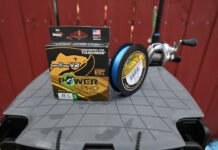Kayak fishing is surprisingly safe, and it can be even safer with the correct safety gear. Hopefully, you will never need any of the following items, but you’ll never regret bringing them on every trip. Pack a five-liter dry bag with a safety kit and keep it on the boat. Better yet, carry these items in the life vest in the event you are separated from the kayak.
Knives and tools aren’t just for fishing. Keep a river knife clipped to the outside of the PFD. In an emergency, cut fishing line, anchor rope or rod leashes.
The blade is sharpened on one side and the thick metal and through-tang allow a river knife to double as a pry bar or hammer.
Lights and beacons help rescuers find you in low visibility. Look for a pocket-sized, waterproof strobe light to attach to the PFD shoulder strap.
Rescue kits can save the day. A handful of bandages, medical tape, painkillers, antacid and antiseptic can be the difference between soldiering on and going home early. Store the safety kit in a waterproof bag.
A 10-foot length of rope or webbing will serve as a dock line, drag rope, lashing and tie down. 550 paracord is handy, but 3/8-inch climbing rope or one-inch webbing are tougher to break and easier to handle.
Whistles and signaling devices get the attention of rescuers or day-dreaming boaters. Keep a pea-less safety whistle tethered to a life vest pocket. In high traffic areas, pack a portable air horn to wake the dead.

Seats
Seats fall into two categories, low-profile and frame seat. Low profile seats sit directly on the kayak deck. Often made of nylon fabric and foam padding, low profile seats are less awkward if the kayak flips over. A low-profile seat also keeps the angler out of the wind. Add extra foam or gel padding and reinforce the back with lumbar support to make a low-profile seat supportive and more comfortable.
Frame seats opened kayak fishing to millions of anglers who are unwilling to sit for hours on a low, hard deck in a puddle of water. These seats resemble a lawn chair with a lightweight metal or plastic frame covered in breathable mesh. Many of these seats can be raised, lowered or removed from the kayak. Higher off the water, larger and heavier with less support, frame seats affect paddling performance. But the comfort tradeoff can be worth it. When taking a kayak for a test drive, be sure the seat is easy to adjust on the water. Add padding and lumbar support to fit the seat for maximum comfort, if necessary.

Other Rigging Equipment
Anchoring systems make it possible to stop the kayak in swift current and stiff breeze. To keep the kayak from flipping over, run the anchor line to the bow or stern using an anchor trolley. Mount a deck loop or pully to the bow and another to the stern. In the center of the kayak, attach another deck loop. Run 550 paracord from the center loop to the bow and stern pulleys and back.
Tie a small carbineer in the center of the rope. Deploy the anchor, clip the rope into the carabineer then use the trolley to run the rope to the bow or stern like raising a flag on a flag pole. Anglers fishing in sandy areas use a collapsible grapple anchor. Add a short length of chain to improve the bite in heavy current. To anchor in a rocky river, 24-inches of heavy chain will wedge into a crevice.
Outriggers and stabilizers add an extra level of security. To stand and fish in heavy seas, outriggers keep the kayak from flipping over. Use an outrigger that can fold out of the way while paddling or docking.
Stakeout poles and push poles make it possible to creep through shallow water and stop on a dime. When stand-up fishing, a push pole is quieter and easier to control than a paddle. To stop and secure the kayak, stick the pole into soft sand or mud and tie off to the anchor trolley. Look for a stakeout pole that breaks into sections for easy storage. Battery-powered, remote-controlled stakeout poles are popular with anglers who need to throw on the brakes in a hurry or often.
Anchoring systems keep the kayak in place. Photo: Will Richardson






